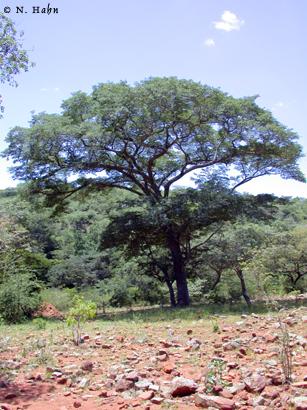 The Miombo
The Miombo
The miombo woodland is characteristic vegetation type found north of the Limpopo dominated by B. spisiformis. This vegetation type spans an area of over 2,7 million km2.
Its first discovery in South Africa
Pollen records have suggested that Brachystegia occurred as fare south as Naboomspruit approximately 19 000 years BP. This finding was the subject of much speculation till recently when Hurter & van Wyk (2001) found a sizable population of Brachystegia in Venda.
A possible Second Species of Brachystegia
From my first visit of this woodland in November 2000 being accompanied by a good friend Troos van de Merwe I became aware of some interesting leaf variation within the lower western section of the Brachystegia. On closer investigation, it became apparent that B. spiciformis leaf form is dominant and the B. utillis - torrei leaf form is rare. In addition various intermediate forms were also observed suggesting that B. utillis - torrei is being assimilated into the dominant B. spiciformis genome.
We were so fare unable to obtain flowering material of the typical B. utillis - torrei leaf form none withstanding various additional expeditions by Troos van de Merwe and myself.
The following species are associated with a tropical floristic element, which reaches its southern distribution within the Soutpansberg: Brackenridgea zanguebarica, Millettia stuhlmannii, Oxytenanthera abyssinica, Trilepisium madagascariensise, Brachystegia utillis - torrei and Syzygium masukuense. The above species are not associated with the central Zimbabwe Miompo floristic element but rather with the Eastern highlands floristic element especially its foothills.
This isolated community Brachystegia woodland would therefore not constitute a relic of the Mimobo woodland, but rather be a relic of an ancient tropical floral element, which extended across the eastern highlands of Zimbabwe into the Soutpansberg.
An additional curiosity has arisen from the Venda common name for the plant "mutsiwa" meaning the one that is left behind. The locals are well aware of the fact that this is an isolated community of Brachystegia woodland with its main distribution being north of the Limpopo River. As fare as can be ascertained the tree is not used ethobotanically.
Further studies are pending to resolve the identity of the second species of Brachystegia.
References
HUTER, P.J.H. & VAN WYK, E. 2001, First distribution recored for Brachystegia spiciformis (Caesalpinioideae) in South Africa. Bothalia 31(1): 43–44.
HAHN, N. (2002). A second species of Brachystegia for South Africa. SABONET News 7(2): 110

